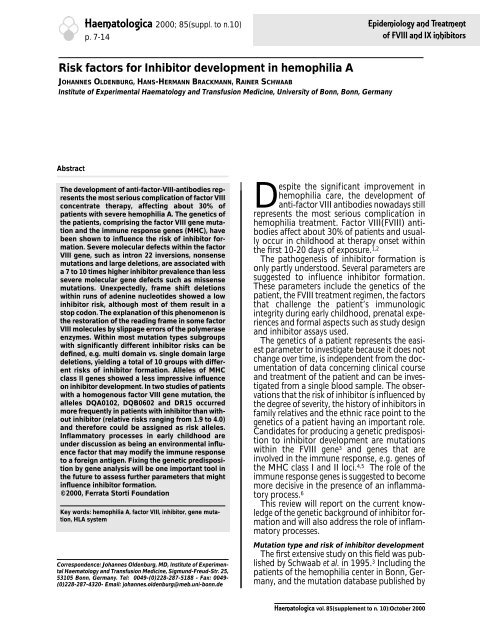Haematologica 2000;85:supplement to no. 10 - Supplements ...
Haematologica 2000;85:supplement to no. 10 - Supplements ...
Haematologica 2000;85:supplement to no. 10 - Supplements ...
You also want an ePaper? Increase the reach of your titles
YUMPU automatically turns print PDFs into web optimized ePapers that Google loves.
<strong>Haema<strong>to</strong>logica</strong> <strong>2000</strong>; <strong>85</strong>(suppl. <strong>to</strong> n.<strong>10</strong>)<br />
p. 7-14<br />
Epidemiology and Treatment<br />
of FVIII and IX inhibi<strong>to</strong>rs<br />
Risk fac<strong>to</strong>rs for Inhibi<strong>to</strong>r development in hemophilia A<br />
JOHANNES OLDENBURG, HANS-HERMANN BRACKMANN, RAINER SCHWAAB<br />
Institute of Experimental Haema<strong>to</strong>logy and Transfusion Medicine, University of Bonn, Bonn, Germany<br />
Abstract<br />
The development of anti-fac<strong>to</strong>r-VIII-antibodies represents<br />
the most serious complication of fac<strong>to</strong>r VIII<br />
concentrate therapy, affecting about 30% of<br />
patients with severe hemophilia A. The genetics of<br />
the patients, comprising the fac<strong>to</strong>r VIII gene mutation<br />
and the immune response genes (MHC), have<br />
been shown <strong>to</strong> influence the risk of inhibi<strong>to</strong>r formation.<br />
Severe molecular defects within the fac<strong>to</strong>r<br />
VIII gene, such as intron 22 inversions, <strong>no</strong>nsense<br />
mutations and large deletions, are associated with<br />
a 7 <strong>to</strong> <strong>10</strong> times higher inhibi<strong>to</strong>r prevalence than less<br />
severe molecular gene defects such as missense<br />
mutations. Unexpectedly, frame shift deletions<br />
within runs of adenine nucleotides showed a low<br />
inhibi<strong>to</strong>r risk, although most of them result in a<br />
s<strong>to</strong>p codon. The explanation of this phe<strong>no</strong>me<strong>no</strong>n is<br />
the res<strong>to</strong>ration of the reading frame in some fac<strong>to</strong>r<br />
VIII molecules by slippage errors of the polymerase<br />
enzymes. Within most mutation types subgroups<br />
with significantly different inhibi<strong>to</strong>r risks can be<br />
defined, e.g. multi domain vs. single domain large<br />
deletions, yielding a <strong>to</strong>tal of <strong>10</strong> groups with different<br />
risks of inhibi<strong>to</strong>r formation. Alleles of MHC<br />
class II genes showed a less impressive influence<br />
on inhibi<strong>to</strong>r development. In two studies of patients<br />
with a homoge<strong>no</strong>us fac<strong>to</strong>r VIII gene mutation, the<br />
alleles DQA0<strong>10</strong>2, DQB0602 and DR15 occurred<br />
more frequently in patients with inhibi<strong>to</strong>r than without<br />
inhibi<strong>to</strong>r (relative risks ranging from 1.9 <strong>to</strong> 4.0)<br />
and therefore could be assigned as risk alleles.<br />
Inflamma<strong>to</strong>ry processes in early childhood are<br />
under discussion as being an environmental influence<br />
fac<strong>to</strong>r that may modify the immune response<br />
<strong>to</strong> a foreign antigen. Fixing the genetic predisposition<br />
by gene analysis will be one important <strong>to</strong>ol in<br />
the future <strong>to</strong> assess further parameters that might<br />
influence inhibi<strong>to</strong>r formation.<br />
©<strong>2000</strong>, Ferrata S<strong>to</strong>rti Foundation<br />
Key words: hemophilia A, fac<strong>to</strong>r VIII, inhibi<strong>to</strong>r, gene mutation,<br />
HLA system<br />
Correspondence: Johannes Oldenburg, MD, Institute of Experimental<br />
Haema<strong>to</strong>logy and Transfusion Medicine, Sigmund-Freud-Str. 25,<br />
53<strong>10</strong>5 Bonn, Germany. Tel: 0049-(0)228-287-5188 - Fax: 0049-<br />
(0)228-287-4320- Email: johannes.oldenburg@meb.uni-bonn.de<br />
Despite the significant improvement in<br />
hemophilia care, the development of<br />
anti-fac<strong>to</strong>r VIII antibodies <strong>no</strong>wadays still<br />
represents the most serious complication in<br />
hemophilia treatment. Fac<strong>to</strong>r VIII(FVIII) antibodies<br />
affect about 30% of patients and usually<br />
occur in childhood at therapy onset within<br />
the first <strong>10</strong>-20 days of exposure. 1,2<br />
The pathogenesis of inhibi<strong>to</strong>r formation is<br />
only partly unders<strong>to</strong>od. Several parameters are<br />
suggested <strong>to</strong> influence inhibi<strong>to</strong>r formation.<br />
These parameters include the genetics of the<br />
patient, the FVIII treatment regimen, the fac<strong>to</strong>rs<br />
that challenge the patient’s immu<strong>no</strong>logic<br />
integrity during early childhood, prenatal experiences<br />
and formal aspects such as study design<br />
and inhibi<strong>to</strong>r assays used.<br />
The genetics of a patient represents the easiest<br />
parameter <strong>to</strong> investigate because it does <strong>no</strong>t<br />
change over time, is independent from the documentation<br />
of data concerning clinical course<br />
and treatment of the patient and can be investigated<br />
from a single blood sample. The observations<br />
that the risk of inhibi<strong>to</strong>r is influenced by<br />
the degree of severity, the his<strong>to</strong>ry of inhibi<strong>to</strong>rs in<br />
family relatives and the ethnic race point <strong>to</strong> the<br />
genetics of a patient having an important role.<br />
Candidates for producing a genetic predisposition<br />
<strong>to</strong> inhibi<strong>to</strong>r development are mutations<br />
within the FVIII gene 3 and genes that are<br />
involved in the immune response, e.g. genes of<br />
the MHC class I and II loci. 4,5 The role of the<br />
immune response genes is suggested <strong>to</strong> become<br />
more decisive in the presence of an inflamma<strong>to</strong>ry<br />
process. 6<br />
This review will report on the current k<strong>no</strong>wledge<br />
of the genetic background of inhibi<strong>to</strong>r formation<br />
and will also address the role of inflamma<strong>to</strong>ry<br />
processes.<br />
Mutation type and risk of inhibi<strong>to</strong>r development<br />
The first extensive study on this field was published<br />
by Schwaab et al. in 1995. 3 Including the<br />
patients of the hemophilia center in Bonn, Germany,<br />
and the mutation database published by<br />
<strong>Haema<strong>to</strong>logica</strong> vol. <strong>85</strong>(<strong>supplement</strong> <strong>to</strong> n. <strong>10</strong>):Oc<strong>to</strong>ber <strong>2000</strong>
















